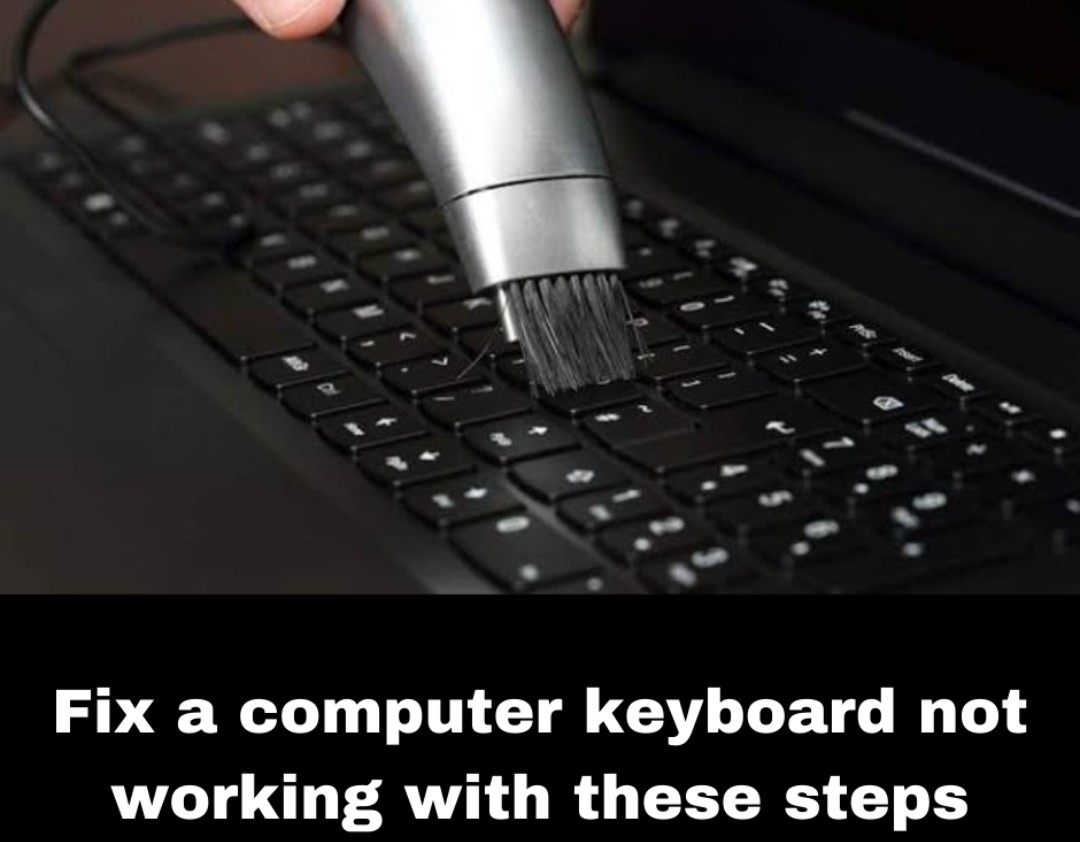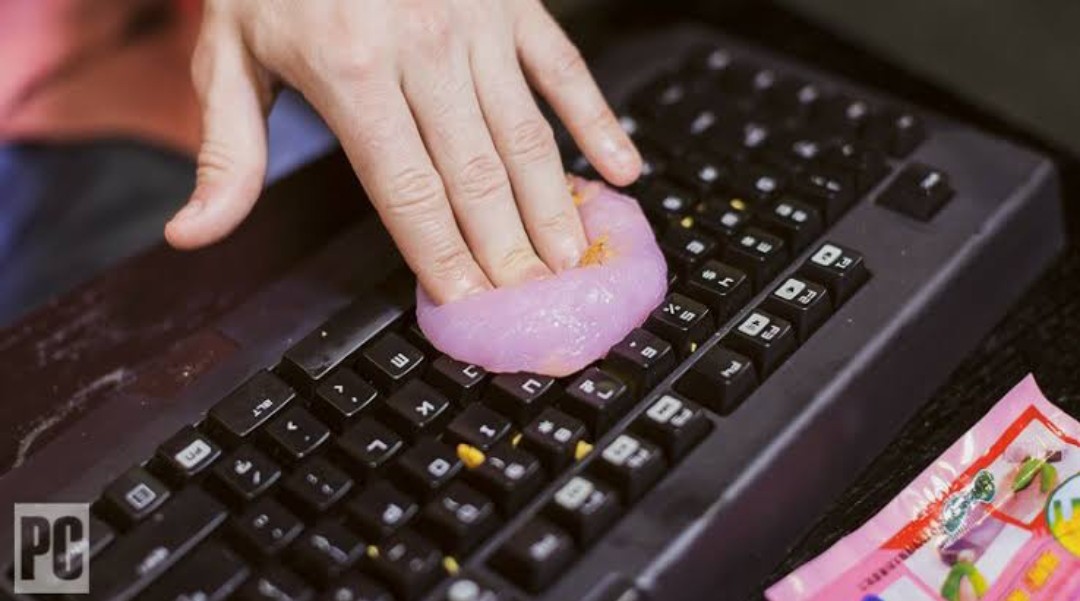A non-functional keyboard can be a frustrating experience, bringing productivity to a halt and hindering your computing tasks. When your computer keyboard isn’t working, it’s important to address the issue promptly to get back to your work smoothly. Computing keyboard serves as an essential tool for communication and interaction with your computer. However, when your computer keyboard stops working or exhibits erratic behavior, it can be a frustrating experience that hinders productivity. In this guide, we’ll walk you through a set of steps to troubleshoot and fix a computer keyboard that’s not working.
Fix a computer keyboard: Diagnosing the Problem

Before we begin with the troubleshooting process, let’s first of all list out some of the likely cause of the keyboard malfunction:
1. Check Physical Connections:
Loose or improperly connected cables can lead to keyboard malfunctions.
2. Restart Your Computer:
Temporary glitches in the system might cause the keyboard to stop working.
3. Inspect for Physical Damage:
Physical damage or debris can affect keyboard functionality.
4. Check for Num Lock or Function Lock:
Accidental activation of Num Lock or Function Lock can cause the keyboard to behave differently.
5. Update or Reinstall Keyboard Drivers:
Outdated or corrupted drivers can lead to keyboard issues.
6. Scan for Malware:
Malware or viruses can interfere with keyboard functionality.
7. Check Accessibility Settings:
Accessibility settings might be affecting keyboard input.
8. Try an External Keyboard:
Testing with an external keyboard can help identify if the problem is with the computer or the original keyboard.
9. Perform a System Update:
An outdated operating system might have compatibility issues with the keyboard.
10. Seek Professional Help:
If all else fails, there could be a hardware issue with the keyboard.
Related Post: How to troubleshoot Connectivity Issues with Wireless Keyboard
Fix a computer keyboard: Common Keyboard Issues and Solutions
Dealing with keyboard issues can be frustrating, especially when it disrupts your work or leisure activities. Here are some common keyboard problems and their respective solutions to help you get your keyboard back in working order:
1. Unresponsive Keys or Characters:
Some keys or characters are not registering when pressed.
Solution:
- Check for Debris: Turn the keyboard upside down and gently tap to remove any debris or particles.
- Key Removal and Cleaning: Carefully remove affected keys and clean underneath to ensure they function correctly.
- Keyboard Replacement: If cleaning doesn’t work, consider replacing the keyboard.
2. Keyboard Types Wrong Characters:
Pressing a key produces a different character than intended.
Solution:
- Check Language Settings: Ensure your keyboard is set to the correct language and region.
- Toggle Num Lock or Function Lock: Accidental activation of these keys can cause typing issues. Toggle them to check.
3. Keyboard is Typing Multiple Characters:
Pressing a key results in the character being typed multiple times.
Solution:
- Adjust Key Repeat Settings: Modify the key repeat rate and delay through your computer’s settings.
- Update Keyboard Drivers: Outdated drivers can cause this issue. Update or reinstall your keyboard drivers.
4. Keyboard is Typing Randomly:
The keyboard produces random characters without pressing any keys.
Solution:
- Check for Software Conflicts: Ensure no conflicting software is running that might interfere with the keyboard.
- Update Operating System: Make sure your operating system is up to date with the latest patches and updates.
5. Bluetooth Keyboard Connectivity Problems:
Bluetooth keyboard is not connecting to your device.
Solution:
- Check Bluetooth Settings: Ensure Bluetooth is turned on and your device is discoverable.
- Reconnect the Keyboard: Remove the device and reconnect it through Bluetooth settings.
6. Keyboard Not Working After Sleep Mode:
The keyboard stops functioning after the computer wakes up from sleep mode.
Solution:
- Restart the Computer: Restarting often resolves this issue.
- Check Power Settings: Adjust power settings to prevent devices from turning off to save power.
7. Spilled Liquid on Keyboard:
Liquid spill affecting keyboard functionality.
Solution:
- Immediately Turn Off and Disconnect: Turn off the computer and disconnect the keyboard. Let it dry completely.
- Clean Thoroughly: Clean and dry the keyboard thoroughly once it’s completely dry to avoid any damage.

8. Keyboard Backlight Not Working:
The backlight on your keyboard is not functioning.
Solution:
- Check Backlight Settings: Ensure backlight settings are enabled in your computer settings or through specific keyboard shortcuts.
- Update Drivers: Update your keyboard drivers to the latest version to ensure compatibility.
9. Wireless Keyboard Not Connecting:
Your wireless keyboard is not connecting to the computer.
Solution:
- Check Power and Batteries: Ensure the keyboard has sufficient power or replace batteries. Charge the keyboard if applicable.
- Re-establish Connection: Follow the manufacturer’s instructions to reconnect the keyboard to your computer.
10. Certain Keys Stuck:
Certain keys appear to be stuck and keep repeating even after releasing them.
Solution:
- Check for Physical Debris: Inspect the affected keys for any debris that might be causing them to stick.
- Key Removal and Cleaning: Gently remove the key and clean underneath. Replace the key and check if the issue is resolved.
11. Keyboard Lag or Delay:
There is a noticeable delay between pressing a key and the character appearing on the screen.
Solution:
- Check for Software Conflicts: Ensure no background applications are causing the lag. Close unnecessary programs.
- Update Operating System: Ensure your operating system is up to date to benefit from performance improvements.
12. Entire Keyboard Not Working:
The entire keyboard is unresponsive.
Solution:
- Restart Your Computer: A simple restart can often fix this issue by refreshing the system.
- Try Another USB Port: If it’s a wired keyboard, try connecting to a different USB port.
13. Keys Not Registering with a Specific Application:
Keyboard functions properly, but certain keys are not registering within a specific application.
Solution:
- Check Application Settings: Verify the application’s keyboard settings to ensure it recognizes all keys.
Addressing these common keyboard issues promptly can save you from unnecessary frustration and disruptions in your daily activities. Keep your keyboard clean, update your drivers, and follow the troubleshooting steps to enjoy a smooth and efficient typing experience. If problems persist, consider seeking professional assistance to resolve the issue effectively.
Fix a computer keyboard: Advanced Troubleshooting
If the basic troubleshooting steps do not resolve the issue, consider these advanced options:
- System Restore: Roll back your system to a previous state using System Restore (Windows) or a similar feature on other operating systems. This can undo recent changes that might be causing keyboard problems.
- Driver Updates: Visit the manufacturer’s website for your keyboard and download the latest drivers. Outdated or corrupted drivers can lead to hardware malfunctions.
Tips for Preventing Keyboard Issues
Preventing keyboard issues is essential to maintain productivity and avoid frustrating disruptions. Here are some effective tips to help you keep your keyboard in optimal condition:
1. Keep it Clean and Dust-Free:
Regularly clean your keyboard using a can of compressed air or a soft brush to remove dust, crumbs, or debris that could affect its functionality.
2. Avoid Eating or Drinking Near the Keyboard:
Keep food and liquids away from the keyboard to prevent accidental spills that can damage the keys or the internal circuitry.
3. Place the Keyboard on a Flat Surface:
Ensure the keyboard is on a stable and flat surface to prevent unnecessary stress on the keys and the internal components.
4. Use a Keyboard Cover:
Consider using a keyboard cover to protect it from spills, dust, and other contaminants, especially if you work in a dusty environment.
5. Turn Off Your Computer Properly:
Shut down your computer correctly using the operating system’s shutdown process to prevent sudden power surges that might damage the keyboard.
6. Use the Keyboard Gently:
Type with a gentle touch to avoid excessive force on the keys, which can lead to key cap damage or a malfunctioning keyboard.
7. Regularly Update Your Operating System:
Keep your operating system up to date to ensure compatibility with the keyboard and benefit from performance enhancements.
8. Update Keyboard Drivers:
Periodically check for and update your keyboard drivers to ensure optimal functionality and compatibility with the operating system.
9. Be Cautious with Cleaning Solutions:
If using cleaning solutions, apply them to a cloth and then clean the keyboard gently. Avoid spraying directly, as excess liquid can damage the keyboard.
10. Secure Wireless Keyboards:
If using a wireless keyboard, ensure a strong and stable wireless connection to prevent intermittent connectivity issues.
11. Regular Maintenance Checks:
Conduct routine maintenance checks to ensure all keys are functioning correctly and there are no signs of physical damage or wear.
12. Invest in Quality Keyboards:
Opt for a high-quality keyboard with a good reputation, durability, and reliability. A quality keyboard is less likely to encounter issues.
Implementing these tips will help you prolong the life of your keyboard and minimize the chances of encountering keyboard-related problems. By maintaining a clean and safe environment for your keyboard and using it with care, you can ensure its smooth functionality for a longer period.
Conclusion
In conclusion, understanding how to prevent and troubleshoot keyboard issues is crucial in maintaining a smooth and productive computing experience. By following best practices such as regular cleaning, gentle usage, and cautious handling, you can mitigate the risks of encountering problems with your keyboard.
Additionally, staying proactive with updates, both for your operating system and keyboard drivers, adds another layer of protection. In the event an issue arises, knowing the troubleshooting steps can swiftly resolve common problems. A well-maintained and properly functioning keyboard is not only a testament to good computing habits but also ensures uninterrupted workflow and enhanced efficiency in your daily tasks.
